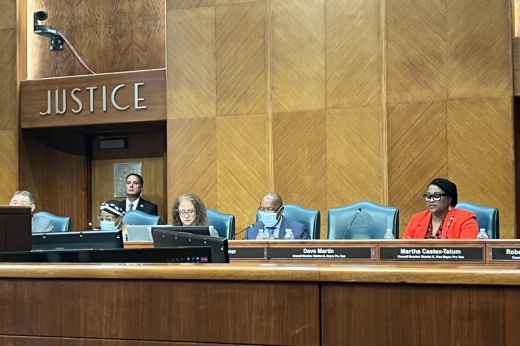As previously reported by Community Impact Newspaper, the redistricting process is done every 10 years based on the decennial census data.
District I Council Member Robert Gallegos said that District J—an area that covers much of southwest Houston—and District H—an area that spans over Woodland Heights, Northside Village and Northline—are specifically at risk of this.
“This is something that we need to look at very carefully,” Gallegos said.
Those two districts along with District I—which Gallegos represents and which covers downtown, EaDo, Clinton Park, parts of northeast Houston and communities along I-45 south from downtown to Hobby Airport—are Hispanic opportunity districts.
According to Gallegos, the Hispanic population is already a large number, and with the added proposed precincts, it is continually growing.
In an email to Community Impact Newspaper, City Attorney Arturo Michel said a Hispanic opportunity district is defined under a test from the court case Thornburg v. Gingles. It refers to a district in which a minority group is large enough to constitute a majority, but the minority group tends to vote in a similar way and the majority votes sufficiently to defeat the minority group’s candidate of choice. When redistricting an opportunity district, a rule of thumb is to have 50% Hispanic for the citizens of voting age, he said.
District J Council Member Edward Pollard said his district was purposely created in 2011 as a Hispanic opportunity district. The lines were drawn to include many of the voting precincts that were heavily populated by Hispanic voters, he said. However, under the proposed maps, the district will be receiving four voting precincts that Gallegos said have a majority white population.
“We’re losing our voters from that district,” Gallegos said. “If you're going to be bringing in precincts, the majority should be Hispanic.”
According to the demographics based on the proposed maps from the city of Houston, the total Hispanic population in District J could be 61.1%. With the previous map from 2019’s American Community Service estimates, the total Hispanic population was 63%. Pollard said despite the added precincts, the Hispanic population is 20%-30% higher than the second represented race in the most current map—non-Hispanic Black/African American at 17.3%.
“The opportunity is still there for the constituents to pick whatever candidate of their choice that they would like,” Pollard said.
Al Castillo, president of the League of United Latin American Citizens’ Council 60, said during the meeting that the Hispanic community should be a priority in the fight for fairness and should be protected by keeping the Hispanic populations in opportunity districts the same.
“Gentrification is a real and present danger for our communities, and then in 10 years, we’ll be 10 years farther behind,” Castillo said.
District H will be receiving voting Precinct 890, which is an area of downtown that Gallegos said could potentially hurt the Hispanic community in the future due to the growing infrastructure and the white population. Gallegos said the majority of the estimated 4,000 voters going into District H are white, and although this may not be a problem right now, it could potentially turn into one within the next 10 years.
As the city moves forward, Houston Mayor Sylvester Turner said demographers need to be careful to take all of these fears into account in order to maintain the opportunity districts.
“We do take into account the diversity of our city and make sure that there is representation of that diversity,” Turner said. “As we move forward, we will be sensitive to all of those concerns.”
With the city’s July 29 deadline for public feedback, Houston activist groups are working on creating maps to submit that could possibly help with what they said is the dilution and inequality in the city. Houston in Action—a group that works on a variety of issues affecting historically excluded communities, such as Black, Latinx and low-income areas—said it will be developing a map that will ensure a strong voice for future local elections of council members.
Juan Cardoza-Oquendo, Houston in Action’s director of public policy, said in an interview with Community Impact Newspaper the group plans to network with other organizations to bring one proposed map to the city by the extended deadline.
“We are very sensitive to keeping the Latinx populations at or above what they are in District J, H and I, and our map proposal will likely do so,” Cardoza-Oquendo said. “But, we are going beyond racial demographics in developing our map and looking at the issues that communities are experiencing.”





